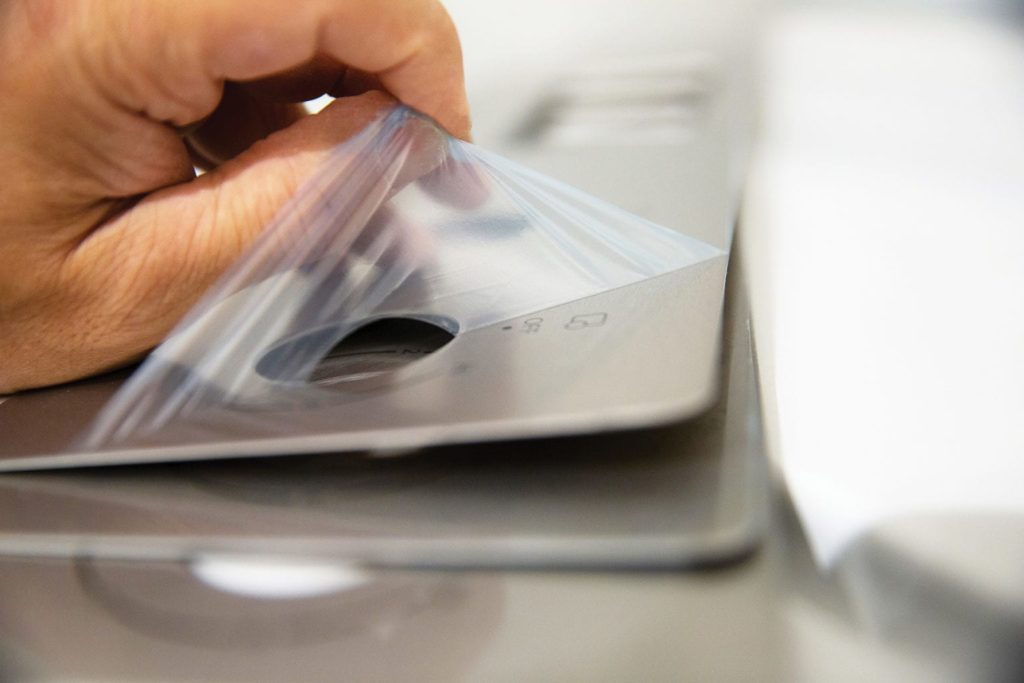Temporary protective coatings may not be designed to last long, but they play a very important role in protecting valuable and easily damaged materials and products during post processing metal fabrication operations, storage, shipment, general handling, and installation in some cases. In fact, they are used on everything from personal electronic products and appliances to brass fixtures and silver-plated housewares to construction materials like piping to automobiles. The coatings are intended to be easily removed without damaging the surface or leaving any residue once they are removed, but while in place must provide protection of surfaces from chipping, abrasion, and other mechanical damage, as well as exposure to chemicals, sunlight, weather, etc.
Traditionally, strippable films have been applied to surfaces by hand or machine as sheets of film during or after manufacturing. The protective films are coated with a pressure-sensitive adhesive designed to bond to surfaces yet remove cleanly when no longer needed. They must be carefully matched to the specific application based on the shape, size, and physical characteristics (including existing coatings) of the part or product to be protected. The type and strength of adhesive on the films must be selected so that the films adhere properly without damaging or creating defects in the coating on the surface that is being protected. Different types of temporary films in various widths and lengths must also be maintained. For some uniquely shaped parts or products, temporary protective films must be specially ordered and die-cut to their particular shapes. As a result, manufacturers must often maintain a significant inventory of temporary films, which adds complexity and cost.
Custom coating and adhesives formulator Universal Chemicals and Coatings (Unichem) has developed an alternative to these strippable films. Its versatile family of solventborne and water-based liquid strippable coatings are applied in the same manner as color coatings or adhesives on coil processing lines. Unlike pre-cut protective films, though, the coatings are applied to whatever width of coil is required, in any thickness, and in formulations that ensure the proper bond is achieved, according to Unichem president, Dan Chin. “These liquid strippable coatings are helping to speed processing, eliminate film inventory, and reduce costs,”
he asserts.
Its versatile family of solventborne and water-based liquid strippable coatings are applied in the same manner as color coatings or adhesives on coil processing lines.
Liquid strippable formulations provide a strong, abrasion-, moisture-, and chemical-resistant barrier and can be designed with varying flexibility and rigidity depending on the intended application, according to Chin. “Strippables can be formulated to meet the performance standards of very specific applications, whether soft and pliable or hard and durable,” he explains.
Typically, any finish coating is applied in a first stage, and the liquid strippable coating is applied in a second stage. Application of the liquid strippable coating often occurs on the entire coil before the coil is slit to specific widths, according to Chin. The coating can also be sprayed on pre-cut sheets or finished parts. It can even be applied using screen-printing techniques when it is necessary to protect a precise area, such as in the case of appliance control panels.
After application, the coating solidifies into a protective film upon heating and processing. Notably, because they have a wide range of adhesion options, the liquid strippable coatings can be used on a variety of substrates, from polished metals to plastics and even other coatings, with the adhesion adjusted and controlled to meet the specific requirements for forming and stamping operations. Once solidified, the coatings provide protection during any post processing application that would be performed by coil processors and manufacturers, such as die-cutting, bending, and even deep-drawing, without damaging the surface, according to Chin.
In the construction industry, a durable liquid strippable coating can be used to protect the finish coating on building products like siding and roofing, even some polyvinylidene difluoride (PVDF) coatings, to protect them from being scratched or marred during shipping and handling. In the automotive sector, the liquid strippable coatings are used to protect vehicle surfaces during transport. For this application, Chin notes that the coatings are formulated to be sprayed on at thicknesses ranging from 3–4 mils to provide sufficient protection from rocks kicked-up by trucks and other vehicles on roadways. “We find that liquid strippables are adding increasing value as an alternative to film laminates on kitchen appliances and construction products, including siding, roofing, garage doors, and roof and wall panels,” he observes.
Unlike pre-cut protective films, liquid strippable coatings are applied to whatever width of coil is required, in any thickness, and in formulations that ensure the proper bond is achieved.
Demand for removable protective coatings is increasing at a modest pace. According to market research firm Credence Research, the global strippable coatings market is expected to expand at a CAGR of 7.2% from 2018 to 2026. The aerospace and military sectors are key drivers of this demand growth. For instance, there is growing interest in temporary peelable camouflage coatings for military applications since they eliminate the need for time-consuming and costly chemical and/or abrasion-based removal methods. UV-curable removable coatings are also attracting attention, particularly for aerospace applications, because they have zero VOCs, reduced curing times, and enhanced resistance to chemical attack.
